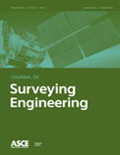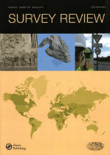
Satellite Navigation
metrics 2024
Advancing the Future of Navigation Research
Introduction
Satellite Navigation, an esteemed journal published by SpringerNature, serves as a pivotal platform for advancing research in the fields of Aerospace Engineering, Electrical and Electronic Engineering, and Signal Processing. Since becoming an Open Access journal in 2020, it has allowed researchers worldwide to freely disseminate their findings, fostering a collaborative academic environment. With remarkable rankings, including the Q1 designation in three prestigious categories and a top percentile placement in Scopus—#2 in Aerospace Engineering and #4 in Computer Science Signal Processing—this journal is committed to publishing high-quality research that drives innovation in satellite navigation technology. As we move forward into the converged years of 2020 to 2024, Satellite Navigation aims to bridge theoretical and practical knowledge, making significant contributions to this vital area of study. Researchers, professionals, and students will find a wealth of valuable insights and advances, solidifying the journal’s status as a cornerstone in the navigation research community.
Metrics 2024
 2.36
2.36 9.00
9.00 9.10
9.10 25
25Metrics History
Rank 2024
Scopus
IF (Web Of Science)
JCI (Web Of Science)
Quartile History
Similar Journals

Journal of Systems Engineering and Electronics
Pioneering Research in Integrated Engineering DisciplinesJournal of Systems Engineering and Electronics is a leading peer-reviewed academic journal dedicated to advancing the field of systems engineering and electronics. Published by the SYSTEMS ENGINEERING & ELECTRONICS, EDITORIAL DEPT, the journal provides a platform for researchers and practitioners to disseminate innovative findings and developments that shape the future of these integrated disciplines. It encompasses a wide range of topics, including systems modeling, control systems, electronic circuit design, and signal processing, thereby appealing to a diverse audience of researchers, professionals, and students. The journal is recognized for its rigorous peer-review process and strives to maintain high academic standards, contributing to its significant impact on the field. Although not currently an Open Access journal, it offers accessible subscription options to ensure that vital research reaches a global audience. With an ISSN of 1004-4132, this journal plays a crucial role in fostering collaboration and scholarly exchange within the rapidly evolving domains of systems engineering and electronics.

MARINE GEODESY
Navigating the Intersection of Oceanography and Geospatial ScienceMARINE GEODESY, an esteemed journal published by Taylor & Francis Inc, delves into the intricate field of oceanography, aiming to contribute profoundly to the understanding of marine spatial dynamics and geophysical processes. With an ISSN of 0149-0419 and an E-ISSN of 1521-060X, this journal has a commendable standing, currently classified in the 2023 Q2 quartile, reflecting its influential presence in the realm of Earth and Planetary Sciences, particularly oceanography, where it ranks 49th out of 145 journals. Since its inception in 1977 and its ongoing publication until 2024, MARINE GEODESY has been dedicated to disseminating groundbreaking research, case studies, and reviews that are crucial for scholars, professionals, and students engaged in the exploration of marine environments. While currently not an open-access journal, it nevertheless offers vital insights into marine geospatial analytics and geodesy, augmenting the knowledge base necessary for tackling contemporary challenges in marine science and geography.

JOURNAL OF SURVEYING ENGINEERING
Transforming Research into Real-World Surveying SolutionsJOURNAL OF SURVEYING ENGINEERING, published by the ASCE-Amercian Society of Civil Engineers, is a pivotal resource in the field of Civil and Structural Engineering, specifically focusing on the advancements and methodologies within surveying practices. Established in 1980, this journal has established itself as a reliable source of high-quality research, boasting an impressive 2023 Q2 ranking in its category, demonstrating its impact and relevance in the engineering community. The journal features rigorously peer-reviewed articles that encourage innovative approaches and solutions in surveying engineering, maintaining a consistent publication schedule through 2024. Although it operates under a traditional access model, the journal remains an influential platform for disseminating essential findings and methodologies. By fostering knowledge exchange among researchers, professionals, and students, the JOURNAL OF SURVEYING ENGINEERING continues to play a critical role in shaping the future of civil engineering research and practice.

Advances in Geodesy and Geoinformation
Bridging Theory and Practice in Earth SciencesAdvances in Geodesy and Geoinformation is a pioneering journal published by the Polish Academy of Sciences, dedicated to the dynamic fields of geodesy and geoinformation. With an ISSN of 2720-7242 and an E-ISSN of 2720-7242, it offers an open-access platform since 2022, making cutting-edge research readily accessible to a global audience. The journal aims to foster the dissemination of innovative methodologies, technologies, and applications in the realms of geospatial data and earth sciences. Researchers, professionals, and students alike can benefit from the high-quality articles that contribute to advancing knowledge in this critical area, bridging theoretical insights and practical solutions. Situated in the heart of Poland, at PL Defilad 1, Warszawa, the journal not only reflects the nation's academic rigor but also positions itself as a crucial hub for international collaboration and knowledge exchange in geodesy and geoinformation.

MICROWAVE JOURNAL
Unveiling the Future of Microwave EngineeringMicrowave Journal, published by Horizon House Publications Inc, is a well-established platform in the field of Electrical and Electronic Engineering, specifically focusing on the advancements and applications of microwave technology. Since its inception in 1969, the journal has consistently delivered high-quality research, making it an invaluable resource for professionals, researchers, and students alike. Despite its Q4 ranking in Scopus for 2023, the journal plays a crucial role in disseminating knowledge and fostering innovation within its niche, showcasing developments across various areas including microwave systems, components, and applications. Although it does not offer Open Access, the journal’s comprehensive insights and peer-reviewed articles are essential for anyone looking to deepen their understanding of microwave engineering. By maintaining a rigorous editorial standard, Microwave Journal continues to shape the discussion and evolution of microwave technology.

SURVEY REVIEW
Illuminating Complex Challenges in Civil and Structural EngineeringSURVEY REVIEW is a distinguished journal published by Taylor & Francis Ltd, focusing on a diverse range of disciplines including Civil and Structural Engineering, Computers in Earth Sciences, and Earth and Planetary Sciences. With an ISSN of 0039-6265 and an E-ISSN of 1752-2706, this journal has been a vital resource for scholarly communication since its inception in 1963. Positioned within the Q2 and Q3 quartile categories according to the latest rankings, it is recognized for its significant contributions to advancing knowledge in multiple fields, specifically holding a rank of 64/159 in Earth and Planetary Sciences and 32/73 in Computers in Earth Sciences. Researchers, professionals, and students benefit from its critical insights into complex engineering and scientific challenges. Although SURVEY REVIEW is not open access, it remains a highly cited journal, making it an essential avenue for disseminating pivotal findings that impact both academia and industry practices.

Chinese Space Science and Technology
Exploring the Frontiers of Space InnovationChinese Space Science and Technology is a pivotal journal dedicated to advancing the field of space engineering and technology, published by the esteemed Chinese Academy of Space Technology. With an ISSN of 1000-758X, this publication serves as a significant platform for cutting-edge research from China and around the globe, spanning vital intersections of Aerospace Engineering, Electrical and Electronic Engineering, and Materials Science. As evidenced by its Q3 ranking in 2023 across these categories, the journal consistently showcases innovative studies that contribute to the development of space technology, thereby impacting both theoretical frameworks and practical applications in the industry. Researchers and professionals will find valuable insights within its pages, while students can enrich their educational journey through its wealth of knowledge. Though primarily published in print, the journal continues to foster collaboration and engagement among the academic community, offering a glimpse into the future of space exploration and technological advancements through its relevant and timely content.

Aerospace Research in Bulgaria
Connecting Bulgarian ingenuity with global aerospace advancements.Aerospace Research in Bulgaria is a prestigious academic journal dedicated to advancing the field of aerospace engineering and technology. Published by the BULGARIAN ACADEMY OF SCIENCES, SPACE RESEARCH & TECHNOLOGY INSTITUTE (SRTI-BAS), this journal serves as a key platform for researchers, engineers, and professionals seeking to share original research, innovative technologies, and critical reviews related to aerospace applications. With the ISSN 1313-0927 and E-ISSN 2367-9522, the journal aims to contribute significantly to the global aerospace community. Although the journal operates under a traditional access model, it emphasizes the importance of research collaboration and disseminating knowledge in the ever-evolving aerospace sector. The editorial team is committed to maintaining high standards in peer review, making it an essential resource for academics and practitioners alike. Located at ACAD. GEORGI BONCHEV STR., SOFIA 1113, BULGARIA, this journal not only highlights Bulgarian contributions to aerospace research but also aims to engage with a broader international audience, fostering advances that propel the industry forward.

Visnyk NTUU KPI Seriia-Radiotekhnika Radioaparatobuduvannia
Empowering Research in Electronic TechnologiesVisnyk NTUU KPI Seriia-Radiotekhnika Radioaparatobuduvannia is a distinguished open-access journal published by the National Technical University of Ukraine, Kyiv Polytechnic Institute. Since its inception in 2009, the journal has been a vital platform for disseminating innovative research findings in the fields of radio engineering, electronic technology, and the development of radio apparatus. With its commitment to providing unrestricted access to high-quality scientific content, the journal aims to foster collaboration and knowledge exchange among researchers, practitioners, and educators both in Ukraine and globally. While the journal's H-index and Scopus rankings are currently not provided, its growing reputation in the academic community is indicative of its impact in advancing technology and engineering practices. The journal's accessibility ensures that cutting-edge research is available to a wide audience, making it a crucial resource for professionals and students seeking to stay informed about the latest advancements in radio technology and engineering.

Navigation-Journal of the Institute of Navigation
Advancing Navigation Science for a Global AudienceNavigation - Journal of the Institute of Navigation (ISSN: 0028-1522, E-ISSN: 2161-4296) is a prestigious academic journal published by the Institute of Navigation (ION) based in the United States. Since its inception in 1946, the journal has aimed to advance and disseminate research in navigation, covering critical topics within the realms of Aerospace Engineering and Electrical and Electronic Engineering. With an impressive Q2 ranking in both fields for 2023 and a notable Scopus rank positioning it within the top quartile of Aerospace Engineering, it serves as an essential resource for researchers, professionals, and students interested in cutting-edge navigation technologies and methodologies. Embracing the Open Access model since 2022, the journal ensures that its high-quality content is readily accessible to a global audience. With a commitment to fostering innovation and collaboration, Navigation plays a pivotal role in shaping the future of navigation science and engineering.